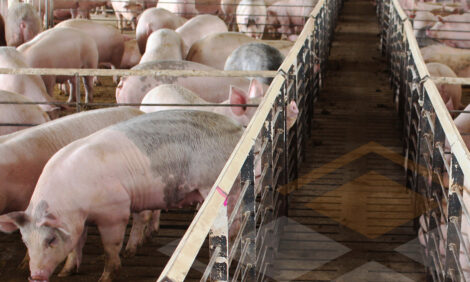



US Pork Outlook Report - August 2004
By U.S.D.A., Economic Research Service - This article is an extract from the August 2004: Livestock, Dairy and Poultry Outlook Report, highlighting Global Pork Industry data. Third-quarter hog prices (51-52 percent lean, live equivalent) are expected to range between $54 and $56 per hundredweight (cwt), on continued strong consumer demand.
In July, the Composite Wholesale Cutout was 25 percent higher than a year ago, and hog prices were up 29 percent. Strong U.S. pork exports are also contributing to higher hog prices, with January-June exports 26 percent higher than the same period last year. Strong demand for U.S. pork products in Japan (+6), Canada (+32), and Mexico (+76) are driven by recovering economies, the lower valued U.S. dollar, and animal disease issues on the beef and poultry sides of the international animal protein market.
Third-Quarter Hog Prices Expected To Stay Strong
|
Weekly Hog Slaughter
Percent change from last year 
|
Consumers Paying More for Pork at Retail
U.S. consumers are paying higher prices at retail for pork products. Second-quarter retail pork prices were $2.77 per pound, or almost 6 percent above the same period last year. For 2004, retail pork prices are expected to average in the upper $2.70s per pound, or, 4-5 percent more than 2003.
Strong Demand Likely To Continue on the Export Side
|
Retail Pork Price
Percent change from previous month 
|
Japan’s import demand appears to be driven by a recovering economy, and lower beef and poultry imports, due to disease issues. Canada is importing more U.S. pork products, despite higher exchange rates, likely due to strong demand for particular cuts that exceed domestic production capabilities. Mexico’s demand for U.S. pork products is likely driven by economic recovery, and competitively priced pork cuts, compared with other animal proteins.
Japanese demand for imported pork products will likely decline somewhat after the August 1 imposition of the Safeguard mechanism. The Safeguard is a WTOsanctioned means of protecting Japanese pork producers from adverse price effects of surges of imported pork products. The Safeguard effectively raises the minimum price at which pork can be imported into Japan by almost 25 percent. In the past, the mere threat of a Safeguard has driven imports from the start of the Japanese fiscal year-- April 1st. This year, the “trigger” level of imports was about 257,000 metric tons (product-weight equivalent). Japanese Government statistics show April-June imports at almost 317,000 metric tons, or, almost 60,000 tons above the trigger level. The Safeguard raises the minimum price of imported pork products from about $1.04 per pound to about $2.68 per pound, and will remain in place until March 31, 2004.
While the higher import price points to lower imports of frozen pork products, in the past, Japanese imports of fresh products have been relatively less affected by the Safeguard. Since fresh pork products typically comprise about half of U.S. exports to Japan, U.S. export flows are typically less affected by the Safeguard, than such countries as Denmark, which exports exclusively frozen products to Japan. Despite the Safeguard imposition, Japanese demand for pork product could remain stronger than in previous periods. With Japanese imports of Asian poultry and North American beef restricted by animal disease issues, pork provides one of the few remaining animal protein alternatives-- in addition to seafood, and domestically produced animal product-- to Japanese consumers.
Links
For more information view the full Livestock, Dairy and Poultry Outlook - August 2004 (pdf)Source: Livestock, Dairy and Poultry Outlook - U.S. Department of Agriculture, Economic Research Service - August 2004






